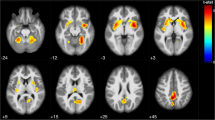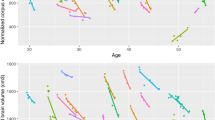Abstract
Cognitive fatigability (CF) can be defined as an inability to maintain performance throughout a sustained cognitive task. Individuals with multiple sclerosis (MS) are more susceptible to CF than healthy controls (HCs); however, the neural correlates underlying CF are still under investigation. Arterial spin labeling (ASL) perfusion imaging provides a non-invasive method of objectively quantifying cerebral blood flow (CBF) during sustained attention tasks. To date, no study has yet evaluated CF in MS using this methodology. 10 MS and 10 HCs completed a 20-min psychomotor vigilance task (PVT). CF was evaluated by dividing the PVT into quintiles and examining performance from the 1st to the last. Mean reaction times (RTs) and number of lapses were recorded. Global and regional CBF changes were evaluated throughout the PVT as well as during pre- and post-task rest. Increased susceptibility to CF was noted in the MS group. Distinct patterns of CBF activation were observed in areas comprising fronto-parietal, cortico-striatal, cerebellar, and basal ganglia regions; however, when and how these regions were engaged differed between the MS and HC groups. In particular, dysfunction in CBF to the middle frontal gyrus may underlie the CF effects observed. In addition, individuals with MS appear to struggle with “switching off” regions of the attentional network at rest following sustained cognitive effort. Findings support the use of ASL as an appropriate methodology for evaluating CF in MS with an overall pattern of attentional network dysfunction being observed. Objectively quantifying CF in this manner can help validate patients’ subjective complaints.





Similar content being viewed by others
References
Aguirre, G. K., Zarahn, E., & D'Esposito, M. (1997). Empirical analyses of BOLD fMRI statistics: II. Spatially smoothed data collected under null-hypothesis and experimental conditions. Neuroimage, 5, 199–212.
Aguirre, G. K., Detre, J. A., Zarahn, E., & Alsop, D. C. (2002). Experimental design and the relative sensitivity of BOLD and perfusion fMRI. Neuroimage, 15, 488–500.
Arnedt, J. T., Owens, J., Crouch, M., Stahl, J., & Carskadon, M. A. (2005). Neurobehavioral performance of residents after heavy night call vs after alcohol ingestion. Journal of the American Medical Association, 294, 1025–1033.
Baehr, E. K., Revelle, W., & Eastman, C. I. (2000). Individual differences in the phase and amplitude of the human circadian temperature rhythm: With an emphasis on morningness-eveningness. Journal of Sleep Research, 9, 117–127.
Bailey, A., Channon, S., & Beaumont, J. (2007). The relationship between subjective fatigue and cognitive fatigue in advanced multiple sclerosis. Multiple Sclerosis, 13, 73–80.
Boksem, M. A., & Tops, M. (2008). Mental fatigue: Costs and benefits. Brain Research Reviews, 59, 125–139.
Brassington, J. C., & Marsh, N. V. (1998). Neuropsychological aspects of multiple sclerosis. Neuropsychology Review, 8, 43–47.
Bryant, D., Chiaravalloti, N. D., & DeLuca, J. (2004). Objective measurement of cognitive fatigue in multiple sclerosis. Rehabilitation Psychology, 49(3), 114–122.
Cabeza, R., & Nyberg, L. (2000). Imaging cognition II: An empirical review of 275 PET and fMRI studies. Journal of Cognitive Neuroscience, 12, 1–47.
Chaudhuri, A., & Behan, P. O. (2004). Fatigue in neurological disorders. Lancet, 363, 978–988.
Coull, J. T., Frackowiak, R. S., & Frith, C. D. (1998). Monitoring for target objects: Activation of right frontal and parietal cortices with increasing time on task. Neuropsychologia, 36, 1325–1334.
DeLuca, J., Chelune, G. J., Tulsky, D. S., Lengenfelder, J., & Chiaravalloti, N. D. (2004). Is speed of processing or working memory the primary information processing deficit in multiple sclerosis? Journal of Clinical and Experimental Neuropsychology, 550–562.
DeLuca, J., Genova, H. M., Hillary, F. G., & Wylie, G. (2008). Neural correlates of cognitive fatigue in multiple sclerosis using functional MRI. Journal of the Neurological Sciences, 270, 28–39.
Detre, J. A., & Wang, J. (2002). Technical aspects and utility of fMRI using BOLD and ASL. Clinical Neurophysiology, 113, 621–634.
Dinges, D. F., Pack, F., Williams, K., Gillen, K. A., Powell, J. W., Ott, G. E., et al. (1997). Cumulative sleepiness, mood disturbance, and psychomotor wigilance performance decrements during a week of sleep restricted to 4-5 hours per night. Sleep, 20, 267–277.
Dobryakova, E., DeLuca, J., Genova, H. M., & Wylie, G. R. (2013). Neural correlates of cognitive fatigue: Cortico-striatal circuitry and effort-reward imbalance. Journal of the International Neuropsychological Society, 19(8), 849–853.
Dubal, S., & Jouvent, R. (2004). Time-on-task effect in trait anhedonia. European Psychiatry, 19, 285–291.
Einӧther, S. J., & Giesbrecht, T. (2013). Caffeine as an attention enhancer: Reviewing exisiting assumptions. Psychopharmacology, 225, 251–274.
Fan, J., McCandliss, B. D., Fossella, J., Flombaum, J. I., & Posner, M. I. (2005). The activation of attentional networks. Neuroimage, 26, 471–479.
Genova, H. M., Rajagopalan, V., DeLuca, J., Das, A., Binder, A., Arjunan, A., Chiaravalloti, N., & Wylie, G. (2013). Examination of cognitive fatigue in multiple sclerosis using functional magnetic resonance imaging and diffusion tensor imaging. PLoS One, 8. https://doi.org/10.1371/journal.pone.0078811.
Gottwald, B., Mihajlovic, Z., Wilde, B., & Mehdorn, H. M. (2003). Does the cerebellum contribute to specific aspects of attention? Neuropsychologia, 41, 1452–1460.
Gui, D., Xu, S., Zhu, S., Fang, Z., Spaeth, A. M., Xin, Y., Feng, T., & Rao, H. (2015). Resting spontaneous activity in the default mode network predicts performance decline during prolonged attention workload. Neuroimage, 120, 323–330.
Kerkhof, G. A., & Van Dongen, H. P. (1996). Morning-type and evening-type individuals differ in the phase position of their endogenous circadian oscillator. Neuroscience Letters, 218, 153–156.
Kim, J., Whyte, J., Wang, J., Rao, H., Tang, K. Z., & Detre, J. A. (2006). Continuous ASL perfusion fMRI investigation of higher cognition: Quantification of tonic CBF changes during sustained attention and working memory tasks. Neuroimage, 31, 376–385.
Kluger, B. P., Krupp, L. B., & Enoka, R. M. (2013). Fatigue and fatigability in neurologic illnesses: Proposal for a unified taxonomy. Neruology, 80, 409–416.
Koenigs, M., Barbey, A. K., Postle, B. R., & Grafman, J. (2009). Superior parietal cortex is critical for the manipulation of information in working memory. Journal of Neuroscience, 29, 14980–14986.
Langdon, D. W., Amato, M. P., Boringa, J., Brochet, B., Foley, F., Fredrikson, S., Hämäläinen, P., Hartung, H. P., Krupp, L., Penner, I. K., Reder, A. T., & Benedict, R. H. (2012). Recommendations for a brief international cognitive assessment for multiple sclerosis (BICAMS). Multiple Sclerosis, 18(891–898), 891–898.
Lim, J., Wu, W. C., Wang, J., Detre, J. A., Dinges, D. F., & Rao, H. (2010). Imaging brain fatigue from sustained mental workload: An ASL perfusion study of the time-on-task effect. Neuroimage, 49, 3426–3435.
Luh, W. M., Wong, E. C., Bandettini, P. A., & Hyde, J. S. (1999). QUIPSS II with thin-slice TI1 periodic saturation: A method for improving accuracy of quantitative perfusion imaging using pulsed arterial spin labeling. Magnetic Resonance in Medicine, 41(6), 1246–1254.
Mackworth, J. F. (1968). Vigilance, arousal, and habituation. Psychological Review, 75, 308–322.
Menon, V., & Uddin, L. Q. (2010). Saliency, switching, attention and control: A network model of insula function. Brain Structure and Function, 214, 655–647.
Minden, S. L., Frankel, D., Hadden, L., Perloffp, J., Srinath, K. P., & Hoaglin, D. C. (2006). The Sonya Slifka longitudinal multiple sclerosis study: Methods and sample characteristics. Multiple Sclerosis, 12, 24–38.
Ogg, R. J., Zou, P., Allen, D. N., Hutchins, S. B., Dutkiewicz, R. M., & Mulhern, R. K. (2007). Neural correlates of a clinical continuous performance test. Magnetic Resonance Imaging, 26(4), 504–512.
Paus, T., Zatorre, R., Hofle, T., Caramanos, Z., Gotman, J., Petrides, M., & Evans, A. (1997). Time-related changes in neural systems underlying attention and arousal during the performance of an auditory vigilance task. Journal of Cognitive Neuroscience, 9, 392–408.
Polman, C. H., Reingold, S. C., Banwell, B., Clanet, M., Cohen, J. A., Filippi, M., Fujihara, K., Havrdova, E., Hutchinson, M., Kappos, L., Lublin, F. D., Montalban, X., O'Connor, P., Sandberg-Wollheim, M., Thompson, A. J., Waubant, E., Weinshenker, B., & Wolinsky, J. S. (2011). Diagnostic criteria for multiple sclerosis: 2010 revisions to the McDonald criteria. Annals of Neurology, 69, 292–302.
Rao, H., Wang, J., Tang, K., Pan, W., & Detre, J. A. (2007). Imaging brain activity during natural vision during CASL perfusion fMRI. Human Brain Mapping, 28, 593–601.
Reicker, L., Tombaugh, T. N., Walker, L., & Freedman, M. S. (2007). Reaction time: An alternative method for assessing the effects of multiple sclerosis on information processing speed. Archives of Clinical Neuropsychology, 22, 655–664.
Roelcke, U., Kappos, L., Lechner-Scott, J., Brunnschweiler, H., Huber, S., Ammann, W., et al. (1997). Reduced glucose metabolism in the frontal cortex and basal ganglia of multiple sclerosis patients with fatigue: A 18F-fluorodeoxyglucose positron emission tomography study. Neurology, 48, 1556–1571.
Schwid, S. R., Covington, M., Segal, B. M., & Goodman, A. D. (2002). Fatigue in multiple sclerosis: Current understanding and future directions. Journal of Rehabilitation Research and Development, 39, 211–224.
Shomstein, S., & Yantis, S. (2006). Parietal cortex mediates voluntary control of spatial and nonspatial auditory attention. Journal of Neuroscience, 26, 435–439.
Walker, L. A. S., Berard, J. A., Berrigan, L. I., Rees, L. M., & Freedman, M. S. (2012). Detecting cognitive fatigue in multiple sclerosis: Method matters. Journal of the Neurological Sciences, 316, 86–92.
Wang, Z., Aguirre, G., Rao, H., Wang, J., Childress, A. R., & Detre, J. A. (2008). Empirical ASL data anlysis using an ASL date procesing tollbox: ASLtbx. Magnetic Resonance Imaging, 26(2), 261–269.
Funding
This study was funded through surplus funds.
Author information
Authors and Affiliations
Corresponding author
Ethics declarations
The authors have no conflicts of interest to declare. All procedures performed in this study involving human participants with in accordance with the ethical standards of the institutional research ethics board and informed consent was obtained.
Additional information
Publisher’s note
Springer Nature remains neutral with regard to jurisdictional claims in published maps and institutional affiliations.
Rights and permissions
About this article
Cite this article
Berard, J.A., Fang, Z., Walker, L.A.S. et al. Imaging cognitive fatigability in multiple sclerosis: objective quantification of cerebral blood flow during a task of sustained attention using ASL perfusion fMRI. Brain Imaging and Behavior 14, 2417–2428 (2020). https://doi.org/10.1007/s11682-019-00192-7
Published:
Issue Date:
DOI: https://doi.org/10.1007/s11682-019-00192-7




